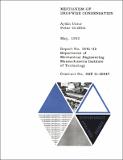| dc.contributor.author | Umur, Aydin | en_US |
| dc.contributor.author | Griffith, P. | en_US |
| dc.contributor.other | Massachusetts Institute of Technology. Division of Industrial Cooperation. | en_US |
| dc.contributor.other | Massachusetts Institute of Technology. Heat Transfer Laboratory. | en_US |
| dc.contributor.other | Massachusetts Institute of Technology. Dept. of Mechanical Engineering. | en_US |
| dc.date.accessioned | 2011-03-04T23:38:03Z | |
| dc.date.available | 2011-03-04T23:38:03Z | |
| dc.date.issued | 1963 | en_US |
| dc.identifier | 14089437 | en_US |
| dc.identifier.uri | http://hdl.handle.net/1721.1/61493 | |
| dc.description.abstract | From a study of surface phenomena, information is obtained about conditions under which net condensation can occur. An experimental examination of the surface, using an optical method capable of detecting thin films of molecular dimensions, shows that no film greater than a monolayer in thickness exists on the area between the drops. Wetted pits and grooves in the surface are considered to be the most probable drop nucleation sites. A model for drop growth gives results that are compatible with experimentally observed values, and show the growth rate to be a function of the vapor pressure. | en_US |
| dc.description.sponsorship | Sponsored by the National Science Foundation | en_US |
| dc.format.extent | iv, 69 p | en_US |
| dc.publisher | Cambridge, Mass. : M.I.T. Dept. of Mechanical Engineering, [1963] | en_US |
| dc.relation.ispartofseries | Technical report (Massachusetts Institute of Technology, Heat Transfer Laboratory) ; no. 25. | en_US |
| dc.subject | Condensation. | en_US |
| dc.subject | Surface chemistry. | en_US |
| dc.subject | Drops. | en_US |
| dc.title | Mechanism of dropwise condensation | en_US |
| dc.type | Technical Report | en_US |
